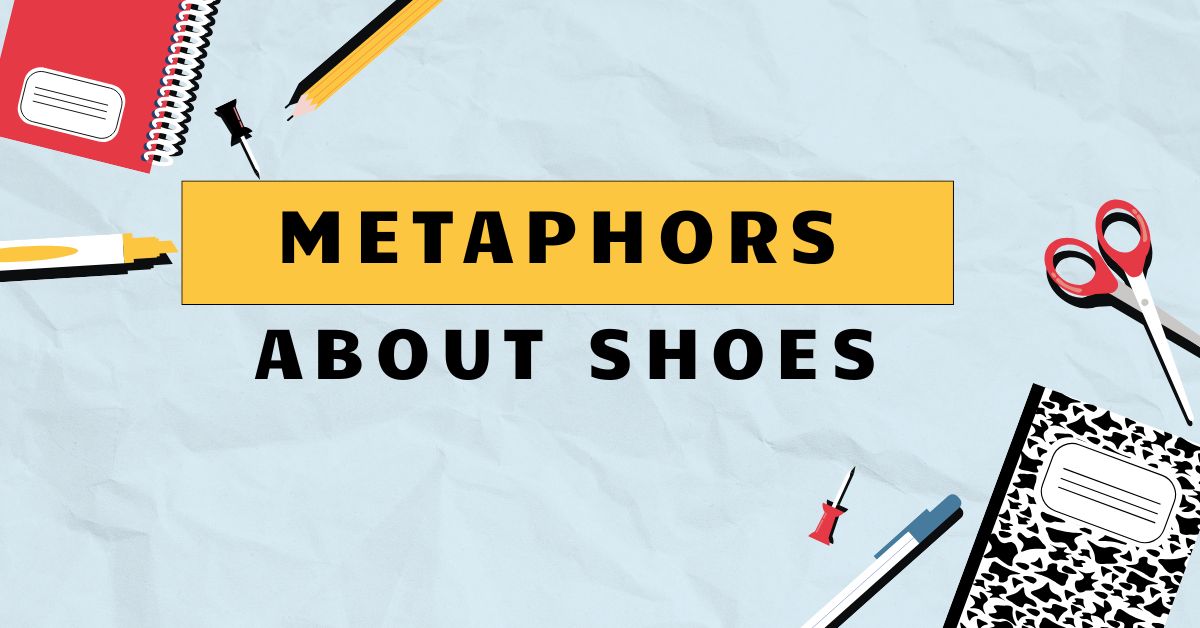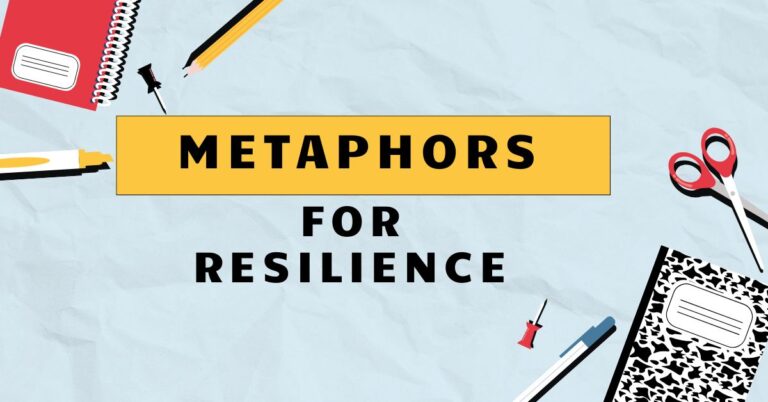33 Stepping into Language: Mastering Metaphors About Shoes
Metaphors are powerful tools that enrich our language, allowing us to express complex ideas in creative and relatable ways. Understanding metaphors, especially those centered around common objects like shoes, can significantly enhance your comprehension and fluency in English.
This article provides a comprehensive guide to metaphors about shoes, exploring their meanings, structures, and usage. Whether you’re an English language learner, a student studying literature, or simply someone who enjoys exploring the nuances of language, this guide will equip you with the knowledge and skills to recognize, interpret, and use shoe metaphors effectively.
Unlock a deeper appreciation for the art of metaphorical expression and elevate your linguistic prowess.
Table of Contents
- Introduction
- Definition of Metaphor
- Structural Breakdown
- Types of Metaphors About Shoes
- Examples of Metaphors About Shoes
- Usage Rules
- Common Mistakes
- Practice Exercises
- Advanced Topics
- FAQ
- Conclusion
Definition of Metaphor
What is a Metaphor?
A metaphor is a figure of speech that directly compares two different things by stating that one thingisthe other. Unlike similes, which use “like” or “as” to make comparisons, metaphors create a more direct and implicit connection.
This comparison is not literal; instead, it suggests a shared quality or characteristic between the two things being compared. The power of a metaphor lies in its ability to evoke imagery and create a deeper understanding of the subject.
For example, saying “time is a thief” doesn’t mean time literally steals things. Instead, it suggests that time, like a thief, takes away our precious moments and opportunities without us realizing it.
This comparison helps us understand the fleeting nature of time in a more vivid and memorable way.
Function of Metaphors
Metaphors serve several important functions in language. First, theyenrich our descriptionsby adding layers of meaning and imagery.
Instead of simply stating facts, metaphors allow us to paint a picture with words, making our communication more engaging and memorable. They alsosimplify complex ideasby relating them to something familiar and understandable.
By drawing parallels between the unknown and the known, metaphors make abstract concepts more accessible.
Furthermore, metaphors canevoke emotions and create empathy. By using figurative language, we can tap into the emotional associations connected with the compared object or idea, allowing us to connect with our audience on a deeper level.
Finally, metaphors are crucial increative writing and literature, adding depth, symbolism, and artistic flair to narratives and poetry. They allow writers to express profound truths and explore complex themes in a concise and impactful manner.
Metaphors and Shoes
Shoes, being a ubiquitous and essential part of our lives, offer a rich source of metaphorical imagery. They can represent a variety of concepts, including journeys, roles, experiences, and social status.
The specific meaning of a shoe metaphor depends heavily on the context in which it is used. For instance, “walking in someone else’s shoes” is a common metaphor for understanding someone else’s perspective or situation, while “filling big shoes” might refer to taking on a challenging role or responsibility.
The versatility of shoe metaphors makes them powerful tools for communication. They allow us to express complex ideas about life, society, and personal experiences in a relatable and engaging way.
By understanding the underlying associations connected with shoes, we can unlock a deeper appreciation for the nuances of metaphorical language.
Structural Breakdown
Tenor and Vehicle
Understanding the structure of a metaphor involves recognizing two key components: thetenorand thevehicle. The tenor is the subject or concept being described, while the vehicle is the object or idea to which the tenor is being compared.
In the metaphor “time is a thief,” time is the tenor, and thief is the vehicle. The vehicle lends its characteristics to the tenor, creating a new understanding of the subject.
In shoe metaphors, the tenor can be a variety of things, such as a life journey, a social role, or a personal experience. The vehicle, of course, is the shoe itself.
The specific qualities of the shoe – its style, condition, or purpose – influence the meaning of the metaphor. For example, “walking in worn-out shoes” might suggest a difficult or challenging stage in life, while “stepping into new shoes” could signify a fresh start or a new opportunity.
Implied Metaphors
While some metaphors are explicitly stated, others are implied. An implied metaphor does not directly state that one thingisanother.
Instead, it hints at the comparison through suggestive language and imagery. This type of metaphor requires the reader or listener to infer the connection between the tenor and the vehicle.
Implied metaphors can be more subtle and nuanced than explicit metaphors, adding depth and complexity to the communication.
An example of an implied shoe metaphor might be: “He laced up and charged into the fray.” Here, the act of “lacing up” suggests preparation and readiness, similar to putting on shoes before embarking on a journey or facing a challenge. The metaphor implies that the person is equipping themselves for a task, drawing a parallel between putting on shoes and preparing for action.
Extended Metaphors
An extended metaphor is a metaphor that is developed over several lines or even throughout an entire work of literature. It involves drawing multiple comparisons between the tenor and the vehicle, exploring various aspects of their relationship.
Extended metaphors can add richness and depth to writing, creating a complex and layered understanding of the subject.
Imagine a poem that uses shoes as an extended metaphor for life’s journey. The poem might describe different types of shoes representing different stages of life – baby shoes for childhood, sturdy boots for adulthood, and worn-out slippers for old age.
The poem could explore the challenges and triumphs of each stage, drawing parallels between the condition and purpose of the shoes and the experiences of life. This extended metaphor would create a powerful and evocative portrayal of the human experience.
Types of Metaphors About Shoes
Shoes as Journeys or Paths
One of the most common uses of shoes in metaphors is to represent journeys or paths in life. Shoes are essential for walking and moving forward, making them a natural symbol for progress and direction.
These metaphors often focus on the type of shoes, the condition of the shoes, or the act of wearing them to convey the nature of the journey.
For example, “walking in someone’s shoes” suggests experiencing their journey or understanding their perspective. Similarly, “worn-out shoes” might represent a difficult or tiring journey, while “new shoes” could symbolize a fresh start or a new adventure.
The specific details of the shoe and the act of wearing it contribute to the overall meaning of the metaphor.
Shoes as Roles or Perspectives
Shoes can also be used to represent different roles or perspectives in life. Just as we wear different shoes for different occasions, we also take on different roles in various situations.
These metaphors often highlight the idea of stepping into someone else’s position or understanding their point of view.
The phrase “if the shoe fits, wear it” suggests accepting a role or responsibility that is well-suited to you. Conversely, “trying to fill big shoes” implies taking on a challenging role or responsibility that requires significant effort and skill.
These metaphors emphasize the connection between shoes and the roles we play in life.
Shoes as Experiences
Shoes can symbolize different types of experiences, both positive and negative. The condition of the shoes, the comfort they provide, and the activities they are used for can all contribute to the metaphorical meaning.
These metaphors often focus on the idea of walking through life and encountering various challenges and opportunities.
For instance, “walking on eggshells” suggests a delicate or precarious experience, where one must be careful to avoid causing offense or problems. “Having to walk a mile in someone else’s shoes” implies a deep understanding of their struggles and hardships.
These metaphors use the imagery of shoes to convey the nature of different experiences.
Shoes as Status or Social Standing
In many cultures, shoes are also associated with social status and economic standing. Expensive, well-maintained shoes can signify wealth and success, while worn-out or inexpensive shoes might indicate poverty or hardship.
These metaphors often reflect societal perceptions and inequalities.
The phrase “blue-suede shoes,” popularized by Elvis Presley, became a symbol of youthful rebellion and a rejection of societal norms. In contrast, “shiny leather shoes” might represent conformity and adherence to traditional values.
These metaphors use shoes to convey messages about social status and cultural identity.
Examples of Metaphors About Shoes
The following tables provide a comprehensive list of examples of shoe metaphors, categorized by their primary meaning. Each example includes a brief explanation of the metaphor’s significance and the connection between the shoes and the concept being represented.
Journey Examples
The following table illustrates metaphors where shoes represent a journey or path in life. These metaphors often highlight the challenges, opportunities, and progress associated with the journey.
| Metaphor | Explanation |
|---|---|
| “Walking in someone else’s shoes” | Understanding another person’s perspective or experience by imagining yourself in their situation. |
| “Wearing worn-out shoes” | Experiencing a difficult or tiring journey, often implying hardship or struggle. |
| “Stepping into new shoes” | Embarking on a fresh start or a new adventure, often implying excitement and anticipation. |
| “Filling the shoes of a legend” | Taking on a challenging role or responsibility previously held by someone highly respected. |
| “Walking a mile in their shoes” | Having a deep understanding of someone’s struggles and hardships through empathy and experience. |
| “Kicking off your shoes” | Relaxing and freeing yourself from the stresses of daily life, often implying a sense of liberation. |
| “Walking around in circles in your shoes” | Feeling lost or directionless, and not making any progress in life. |
| “Having itchy feet in your shoes” | Feeling restless and eager to travel or move on to something new. |
| “Putting on your walking shoes” | Preparing for a long and arduous journey or task, implying determination and resilience. |
| “Wearing shoes that pinch” | Being in a situation or role that is uncomfortable or ill-suited for you. |
| “Walking on thin ice in your shoes” | Being in a risky or precarious situation, where one wrong step could lead to disaster. |
| “Treading carefully in your shoes” | Being cautious and deliberate in your actions, often to avoid causing problems or offense. |
| “Following in someone’s footsteps in their shoes” | Imitating someone’s behavior or career path, often with the goal of achieving similar success. |
| “Walking tall in your shoes” | Being confident and proud of your accomplishments, regardless of challenges or obstacles. |
| “Standing in someone’s shoes” | Taking someone’s place or position, often temporarily, to understand their responsibilities. |
| “Losing your shoes” | Losing your way in life, or feeling disconnected from your purpose and goals. |
| “Finding your shoes” | Discovering your true path in life, or regaining a sense of direction and purpose. |
| “Having big shoes to fill” | Being challenged to meet high expectations or replace someone with exceptional abilities. |
| “Putting yourself in someone else’s shoes” | Empathizing with someone by imagining their situation and feelings. |
| “Walking a tightrope in your shoes” | Balancing competing demands or navigating a difficult situation that requires precision and skill. |
| “Walking uphill in your shoes” | Facing challenges and obstacles in life that require significant effort and perseverance. |
| “Walking on roses in your shoes” | Experiencing a pleasant or easy journey, free from hardship or struggle. |
| “Walking through mud in your shoes” | Dealing with difficult or unpleasant situations, often involving negativity or setbacks. |
| “Walking on sunshine in your shoes” | Feeling happy and optimistic about life, often after overcoming challenges or achieving success. |
| “Walking barefoot” | Living a simple or unencumbered life, free from material possessions and social constraints. |
Role Examples
This table provides examples of metaphors where shoes represent different roles or perspectives. These metaphors often highlight the responsibilities, challenges, and expectations associated with the role.
| Metaphor | Explanation |
|---|---|
| “If the shoe fits, wear it” | Accepting a role or responsibility that is well-suited to you. |
| “Trying to fill big shoes” | Taking on a challenging role or responsibility that requires significant effort and skill. |
| “Stepping into the shoes of a leader” | Assuming a leadership position and taking on the responsibilities and challenges that come with it. |
| “Wearing the wrong shoes” | Being in a role or situation that is not suitable for your skills or personality. |
| “Having to change your shoes” | Adapting to a new role or situation that requires different skills or approaches. |
| “Standing in someone’s shoes” | Understanding someone’s role and responsibilities by temporarily taking their place. |
| “Walking in someone’s work boots” | Understanding the demands and challenges of a particular job or profession. |
| “Stepping into the shoes of a teacher” | Taking on the role of an educator and guiding others in their learning journey. |
| “Wearing shoes that are too tight” | Feeling constrained or limited in a role or situation that does not allow for personal growth or expression. |
| “Having to walk a mile in a doctor’s shoes” | Understanding the pressures and responsibilities of the medical profession. |
| “Putting on your dancing shoes” | Preparing for a social event or activity that requires enthusiasm and energy. |
| “Wearing shoes of authority” | Exercising power and influence in a leadership position. |
| “Walking in the shoes of a parent” | Understanding the responsibilities and sacrifices involved in raising children. |
| “Stepping into the shoes of an artist” | Embracing creativity and expressing oneself through various art forms. |
| “Wearing shoes that don’t fit” | Being in a role or situation that is uncomfortable or unsuitable for your abilities. |
| “Having to walk a mile in a firefighter’s shoes” | Appreciating the courage and dedication of those who risk their lives to protect others. |
| “Putting on your thinking shoes” | Preparing to engage in deep thought and problem-solving. |
| “Wearing shoes of responsibility” | Taking on commitments and obligations with a sense of duty and accountability. |
| “Walking in the shoes of a volunteer” | Understanding the rewards and challenges of helping others in need. |
| “Stepping into the shoes of an entrepreneur” | Taking on the risks and rewards of starting and running a business. |
| “Wearing shoes that are too big” | Feeling overwhelmed or inadequate in a role or situation that exceeds your current capabilities. |
| “Having to walk a mile in a soldier’s shoes” | Understanding the sacrifices and hardships endured by those who serve in the military. |
| “Putting on your negotiating shoes” | Preparing to engage in discussions and compromise to reach an agreement. |
| “Wearing shoes of compassion” | Showing empathy and understanding towards others in their struggles. |
Experience Examples
This table highlights metaphors where shoes represent different types of experiences. These metaphors often focus on the emotional impact and challenges associated with the experience.
| Metaphor | Explanation |
|---|---|
| “Walking on eggshells” | Being in a delicate or precarious situation, where one must be careful to avoid causing offense or problems. |
| “Walking on clouds” | Feeling extremely happy and joyful, often after a positive event or achievement. |
| “Having to walk a mile in someone else’s shoes” | Having a deep understanding of someone’s struggles and hardships through empathy and experience. |
| “Walking through fire” | Enduring intense challenges and difficulties in pursuit of a goal. |
| “Walking in darkness” | Experiencing uncertainty and confusion during a difficult period in life. |
| “Walking on broken glass” | Experiencing painful and traumatic events that leave lasting scars. |
| “Walking a rocky road” | Facing numerous obstacles and setbacks on the path to success. |
| “Walking on sunshine” | Feeling optimistic and positive about the future, despite past challenges. |
| “Walking through a storm” | Navigating a period of intense stress and turmoil. |
| “Walking on quicksand” | Being in a situation that is unstable and likely to worsen. |
| “Walking on a tightrope” | Balancing competing demands or navigating a difficult situation that requires precision and skill. |
| “Walking uphill” | Facing challenges and obstacles that require significant effort and perseverance. |
| “Walking on roses” | Experiencing a pleasant or easy journey, free from hardship or struggle. |
| “Walking through mud” | Dealing with difficult or unpleasant situations, often involving negativity or setbacks. |
| “Walking on water” | Achieving something seemingly impossible or miraculous. |
| “Walking in circles” | Feeling lost or directionless, and not making any progress. |
| “Walking on air” | Feeling elated and carefree, often due to romantic feelings or success. |
| “Walking on thin ice” | Being in a risky or precarious situation, where one wrong step could lead to disaster. |
| “Walking in someone’s shadow” | Being overshadowed by someone else’s accomplishments or influence. |
| “Walking a fine line” | Balancing opposing forces or navigating a delicate situation that requires caution and diplomacy. |
| “Walking on coals” | Enduring extreme pain or suffering for a cause or belief. |
| “Walking on fire” | Showing great courage and determination in the face of adversity. |
| “Walking on pins and needles” | Feeling anxious and apprehensive about an impending event or decision. |
| “Walking in a dream” | Feeling detached from reality, as if in a surreal or otherworldly state. |
Status Examples
This table provides examples of metaphors where shoes represent social status or economic standing. These metaphors often reflect societal perceptions and inequalities.
| Metaphor | Explanation |
|---|---|
| “Blue suede shoes” | Representing youthful rebellion and a rejection of societal norms. |
| “Shiny leather shoes” | Representing conformity and adherence to traditional values. |
| “Wearing designer shoes” | Signifying wealth, status, and a desire to impress others. |
| “Walking in old, patched-up shoes” | Representing poverty, hardship, and a lack of resources. |
| “Having shoes that are always polished” | Signifying attention to detail, professionalism, and a desire to maintain a respectable appearance. |
| “Walking in worn-out sneakers” | Representing a casual, unpretentious lifestyle. |
| “Wearing high heels” | Signifying femininity, elegance, and a desire to appear sophisticated. |
| “Having shoes that are custom-made” | Representing exclusivity, luxury, and a high level of personal attention. |
| “Walking in sturdy work boots” | Representing a working-class background and a dedication to hard labor. |
| “Wearing shoes that are scuffed and dirty” | Representing neglect, indifference, or a lack of concern for appearances. |
| “Having shoes that are always spotless” | Signifying cleanliness, orderliness, and a desire to maintain a pristine image. |
| “Walking in sandals” | Representing a relaxed, informal lifestyle. |
| “Wearing expensive loafers” | Signifying wealth, leisure, and a refined sense of style. |
| “Having shoes that are falling apart” | Representing financial instability, neglect, and a lack of resources. |
| “Walking in bare feet” | Representing simplicity, humility, and a connection to nature. |
Usage Rules
Contextual Appropriateness
The effectiveness of a metaphor depends heavily on its contextual appropriateness. A metaphor that works well in one situation may be confusing or inappropriate in another.
Consider your audience, the setting, and the overall tone of your communication when choosing a metaphor. A formal presentation, for example, might require more sophisticated and carefully chosen metaphors than a casual conversation with friends.
When using shoe metaphors, think about the specific associations that shoes have in different contexts. A metaphor about “walking in someone’s shoes” might be suitable for a discussion about empathy and understanding, but it would be less appropriate in a discussion about financial investments.
Always ensure that your metaphor aligns with the overall message and purpose of your communication.
Cultural Sensitivity
Metaphors are often rooted in cultural experiences and beliefs, which means they can be interpreted differently across cultures. Be mindful of potential cultural differences when using metaphors, especially when communicating with people from diverse backgrounds.
A metaphor that is common and easily understood in one culture may be unfamiliar or even offensive in another.
Shoes, in particular, can have different cultural connotations. In some cultures, shoes are considered unclean and should not be worn indoors, while in others, they are a symbol of status and respect.
Avoid using shoe metaphors that could be misinterpreted or that might perpetuate negative stereotypes. When in doubt, it’s always best to err on the side of caution and choose more neutral language.
Clarity and Relevance
A good metaphor should be clear and relevant to the topic at hand. If a metaphor is too obscure or convoluted, it will only confuse your audience and detract from your message.
Make sure that the connection between the tenor and the vehicle is easily understandable and that the metaphor adds value to your communication.
Avoid using metaphors simply for the sake of using them. A metaphor should serve a purpose – to clarify, to emphasize, or to evoke emotion.
If a metaphor doesn’t enhance your communication in some way, it’s better to leave it out. Always prioritize clarity and relevance over cleverness or originality.
Common Mistakes
Mixed Metaphors
A mixed metaphor occurs when two or more incompatible metaphors are combined in a single expression. This can create confusion and undermine the effectiveness of your communication.
For example, saying “We need to nip it in the bud before it snowballs out of control” combines the metaphor of nipping a bud (stopping something early) with the metaphor of a snowball growing larger (something escalating). These two images don’t fit together logically, resulting in a mixed metaphor.
To avoid mixed metaphors, be careful to choose metaphors that are consistent and coherent. If you’re using a shoe metaphor, stick with images and associations that relate to shoes.
Avoid mixing shoe metaphors with other types of metaphors that don’t align with the overall theme.
Overused Metaphors
Some metaphors are so common that they have become clichés. While these metaphors may be easily understood, they often lack impact and originality.
Overusing these metaphors can make your writing or speaking sound uninspired and predictable. Examples of overused metaphors include “thinking outside the box” and “a level playing field.”
Try to avoid overused metaphors whenever possible. Instead, look for fresh and creative ways to express your ideas.
If you do use a common metaphor, try to give it a unique twist or apply it in a new and unexpected way. This will help you make your communication more engaging and memorable.
Misinterpretation
Even well-chosen metaphors can be misinterpreted if your audience doesn’t share your cultural background or assumptions. Be aware of the potential for misinterpretation and try to anticipate how your audience might perceive your metaphors.
If you’re unsure whether a metaphor will be understood, it’s better to explain it explicitly or choose a different way to express your idea.
When using shoe metaphors, consider that different people may have different associations with shoes. Someone who has never worn high heels, for example, might not understand the metaphor of “walking in high heels” in the same way as someone who wears them regularly.
Provide context and explanation when necessary to ensure that your metaphors are understood as intended.
Practice Exercises
Exercise 1: Identifying Metaphors
Identify the metaphors in the following sentences and explain their meaning. This exercise will help you recognize metaphors in context and understand their underlying significance.
| Question | Answer |
|---|---|
| 1. He was walking on eggshells around his boss. | Walking on eggshells is a metaphor for being in a delicate or precarious situation, where one must be careful to avoid causing offense or problems. |
| 2. She stepped into the shoes of a CEO after her mentor retired. | Stepped into the shoes of a CEO is a metaphor for assuming a leadership position and taking on the responsibilities and challenges that come with it. |
| 3. The project was walking uphill from the start. | Walking uphill is a metaphor for facing challenges and obstacles that require significant effort and perseverance. |
| 4. If the shoe fits, wear it. | If the shoe fits, wear it is a metaphor for accepting a role or responsibility that is well-suited to you. |
| 5. After her win, she was walking on clouds. | Walking on clouds is a metaphor for feeling extremely happy and joyful after a positive event or achievement. |
| 6. He had to walk a mile in her shoes to understand her pain. | Walking a mile in her shoes is a metaphor for having a deep understanding of someone’s struggles and hardships through empathy and experience. |
| 7. The company was walking on thin ice due to its debts. | Walking on thin ice is a metaphor for being in a risky or precarious situation, where one wrong step could lead to disaster. |
| 8. He was trying to fill some very big shoes after his predecessor left. | Filling big shoes is a metaphor for taking on a challenging role or responsibility that requires significant effort and skill. |
| 9. After the vacation, he kicked off his shoes and relaxed. | Kicked off his shoes is a metaphor for relaxing and freeing yourself from the stresses of daily life, often implying a sense of liberation. |
| 10. She put on her dancing shoes and enjoyed the party. | Putting on her dancing shoes is a metaphor for preparing for a social event or activity that requires enthusiasm and energy. |
Exercise 2: Creating Metaphors
Create your own metaphors about shoes to describe the following situations. This exercise will help you develop your ability to use metaphors creatively and effectively.
| Situation | Your Metaphor |
|---|---|
| Starting a new job | Stepping into brand new, polished shoes, ready to make a strong impression. |
| Dealing with a difficult relationship | Walking on a path strewn with sharp rocks, each step a painful reminder of the challenges. |
| Achieving a long-term goal | Finally reaching the summit after a long climb in well-worn, reliable boots. |
| Feeling overwhelmed with responsibilities | Trying to juggle too many shoes, each representing a different demand on your time and energy. |
| Experiencing a major life change | Having to completely replace your old, familiar shoes with a new, unfamiliar pair. |
| Learning something new | Trying on a pair of shoes that initially feel awkward but gradually become more comfortable. |
| Overcoming a personal challenge | Walking through fire in heat-resistant boots, emerging stronger and more resilient. |
| Finding your true passion | Discovering a pair of shoes that fit perfectly, allowing you to move with grace and purpose. |
| Working under pressure | Walking on a tightrope in slippery
shoes, requiring constant focus and balance. |
| Supporting a friend in need | Walking alongside them in sturdy shoes, offering stability and encouragement. |
Interpreting Metaphors
Interpret the meaning of the following shoe metaphors in the context of a short story. This exercise will help you analyze metaphors in literature and understand their deeper significance.
Story Excerpt:
“Sarah had always been known for her shiny, expensive shoes. They were a symbol of her success, her status in the company.
But when the company faced a crisis, Sarah found herself walking on eggshells, careful not to upset anyone. One day, she decided to kick off her heels and put on her work boots, joining her team in the trenches.
It was a difficult journey, but she knew that if they all walked together, they could weather the storm.”
| Metaphor | Interpretation |
|---|---|
| Shiny, expensive shoes | Represent Sarah’s initial focus on status and success, highlighting her position in the company. |
| Walking on eggshells | Indicates Sarah’s careful and cautious behavior during the company crisis, fearing to make a wrong move. |
| Kick off her heels and put on her work boots | Symbolizes Sarah’s decision to abandon her focus on status and instead join her team in hard work and dedication. |
| Walked together | Walking together represents the collective effort and unity required to overcome the challenges facing the company. |
| Weather the storm | Weather the storm represents the ability to overcome the difficulteis. |
Advanced Topics
Metaphors in Literary Analysis
Metaphors are a fundamental element of literary analysis, providing insight into a text’s themes, characters, and overall meaning. When analyzing literature, pay close attention to the metaphors used by the author and consider their significance in the context of the work.
Ask yourself what the tenor and vehicle of each metaphor are, and how the comparison enhances your understanding of the subject.
Shoe metaphors, in particular, can be rich sources of literary interpretation. Consider how shoes are used to represent characters’ journeys, social roles, or personal experiences.
Analyze the symbolism of different types of shoes and the implications of characters wearing or not wearing them. By carefully examining shoe metaphors, you can unlock deeper layers of meaning in literary texts.
Using Metaphors in Creative Writing
Metaphors are essential tools for creative writers, allowing them to express complex ideas in vivid and imaginative ways. When writing creatively, experiment with different types of metaphors to find the ones that best convey your message and evoke the desired emotions in your readers.
Don’t be afraid to take risks and create original metaphors that challenge conventional thinking.
Shoe metaphors can be particularly effective in creative writing, offering a wide range of possibilities for symbolism and imagery. Use shoes to represent characters’ inner lives, their relationships with others, or the challenges they face.
Explore the metaphorical potential of different types of shoes – from worn-out boots to elegant heels – and consider how they can add depth and nuance to your writing.
FAQ
What is the difference between a metaphor and a simile?
A metaphor directly compares two things by stating that one thing is the other, while a simile compares two things using “like” or “as.” For example, “time is a thief” is a metaphor, while “time is like a thief” is a simile.
How can I improve my understanding of metaphors?
Read widely, pay attention to how metaphors are used in different contexts, and practice identifying and interpreting metaphors in texts. The more you engage with metaphors, the better you’ll become at understanding them.
Are there any cultures where shoe metaphors are particularly common?
Shoe metaphors are common in many cultures, but their specific meanings can vary. In some cultures, shoes are closely associated with social status, while in others, they are more connected with journeys and experiences.
Researching cultural attitudes towards shoes can provide valuable insights into the interpretation of shoe metaphors.
How can I avoid using clichés in my writing?
Be aware of common clichés and actively seek out fresh and original ways to express your ideas. Use a thesaurus to find alternative words and phrases, and challenge yourself to think creatively about your subject.
What are some other common types of metaphors?
Other common types of metaphors include metaphors about time, nature, and the human body. Exploring these different types of metaphors can broaden your understanding of figurative language and enhance your communication skills.
Conclusion
Metaphors about shoes offer a rich and versatile way to express complex ideas and emotions. By understanding the structure, types, and usage rules of these metaphors, you can enhance your communication skills and deepen your appreciation for the art of figurative language.
Whether you’re analyzing literature, writing creatively, or simply engaging in everyday conversation, mastering shoe metaphors will equip you with a powerful tool for expressing yourself with clarity, creativity, and impact. So, step into the world of metaphors, and let your language take you on a journey of discovery and expression.







